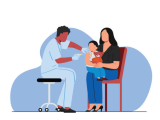Mar 3, 2010 (CIDRAP News) A new estimate on the annual health burden of foodborne illnesses in the United States puts the cost at $152 billion, an amount much higher than previous estimates, but one that the author of today's report hopes will spur action from policymakers.
A previous estimate from the US Department of Agriculture of the economic cost of foodborne illness was $6.9 billion a year. However the author of today's 27-page report, Robert L. Scharff, a professor of consumer sciences at The Ohio State University, said that the earlier estimate covers only five pathogens and does not factor in health-related pain and suffering.
Scharff, a former economist with the Food and Drug Administration (FDA), produced the report for the Produce Safety Project, which is affiliated with The Pew Charitable Trusts at Georgetown University in Washington, DC.
Scharff said the report is designed to be a tool to help policymakers grapple with the economic burden of foodborne illnesses, relative to other pressing issues. He added that his estimate may be conservative, because it does not factor in costs to government or to the food industry. The report breaks down the foodborne illness cost among 28 different pathogens and estimates the burden on each state.
The new estimate comes as major food safety legislation stalls in the US Senate. Last July the US House of Representatives passed a food safety bill, and at the end of November a US Senate committee, with unanimous bipartisan support, cleared the FDA Food Safety Modernization Act.
Scharff said today in a statement from the Pew Foundation, "This study puts the problem of foodborne illness in its proper perspective and should help facilitate reasonable action designed to mitigate this problem."
Erik Olson, director of food and consumer product safety with the Pew Health Group, said in the statement that it's clear that gaps in the food safety system are creating significant health and economic impacts. "Especially in challenging economic times we cannot afford to waste billions of dollars fighting preventable diseases after it is too late," he said. "The Senate needs to act on this now and pass legislation that will improve protections for public health."
The report uses the FDA's cost-estimate approach, which calculates medical costs (physician services, pharmaceutical products, and hospitalization) and losses to quality of life (lost life expectancy, pain and suffering, and functional disability). Using data from the Centers for Disease Control and Prevention (CDC), Scharff broke out the cost of produce-related foodborne illnesses, nearly $39 billion each year.
In assessing the cost of illness per patient for each pathogen, Vibrio vulnificus was the highest, at more than $3 million per case, while Bacillus cereus was the lowest at $226 per case. In terms of costs to US taxpayers, Campylobacter and nontyphoidal Salmonella infections were the two most expensive illnesses, with respective yearly price tags of nearly $19 million and $15 million.
Costs to each state varied by the size of the state as well as each state's exposure to different foodborne pathogens and the cost of medical care. In its state rankings of per capita foodborne illness costs, the top five for the highest costs per case were Hawaii, Florida, Connecticut, Pennsylvania, and South Carolina. The five lowest were Montana, Idaho, Utah, Wyoming, and Kentucky.
Bill Marler, a well-known food-safety attorney based in Seattle, told CIDRAP News today that the new cost analysis does a good job drilling down to the health and personal injury toll of foodborne illness outbreaks, but added that food safety officials and legislators should realize the enormity of business losses in the wake of such outbreaks.
He said from his experience, the personal injury cost is relatively small when compared with the financial damages the businesses and industries incur. He cited recent examples involving contaminated peanuts, spinach, and tomatoes.
He estimated that economic damage to businesses is eight- to tenfold greater than the personal injury costs, adding that the number would be "overwhelmingly stunning."
See also:
Mar 3 Produce Safety Project press release with link to foodborne illness cost report
http://www.producesafetyproject.org/media?id=0009
Mar 3 Pew Health Group press release



















